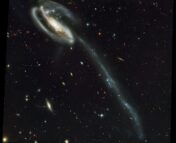The Undergraduate Research series is where we feature the research that you’re doing. If you are an undergraduate that took part in an REU or similar astro research project and would like to share this on Astrobites, please check out our submission page for more details. We would also love to hear about your more general research experience!
Rose Hewald1, Nikolas Younker2, Prasanna Adhikari2, Lauren Elicker2, Emmy Bursk2
1University of Notre Dame, 2University of Cincinnati

Rose Hewald is an undergraduate sophomore at the University of Notre Dame studying Physics. Nikolas is an undergraduate 4th year at the University of Cincinnati studying Aerospace Engineering with a minor in Astrophysics. Prasanna is an undergraduate junior at the University of Cincinnati majoring in Astrophysics with a minor in computer science. Lauren is a recent graduate of the University of Cincinnati, having studied physics and astrophysics. Emily Bursk is a junior at the University of Cincinnati studying Astrophysics. This research was completed as part of a summer project at the University of Cincinnati under the supervision of Dr. Matthew Bayliss.
The JWST Science Calibration Pipeline is used to produce data and exposures from its various instruments and modes. The data used was NIRSPEC (Near-Infrared Spectrograph) IFU (Integral Field Unit) gathered from the MAST Web Portal, which is accessible to the public. From JWST documentation, NIRSPEC IFU data is able to provide powerful multiplexing spectroscopy and high contrast spectroscopy for uses in galaxy formation and evolution, characterization of stellar populations and exoplanet atmospheres and spatially resolved spectroscopy of extended targets; more can be found on the type of data here. Focusing on the NIRSpec IFU data for the galaxy targets SGAS-1723, SGAS-1226, SPT0418-47, and SPT2147-50, we followed a public “cookbook” written by the TEMPLATES ERS team and installed the JWST pipeline. From there, we can reduce raw JWST data and create data cubes. We documented the pipeline installation and NIRSpec IFU data reduction processes, taking notes on what steps worked, what steps produced errors, and how we solved any issues that we encountered, ultimately constructing a how-to guide for JWST NIRSpec IFU data reduction. We intend for this guide to be used as a resource for any individual at any level of research who is interested in reducing NIRSpec IFU data. Check out the guide at this link!
Astrobite edited by Jessie Thwaites




